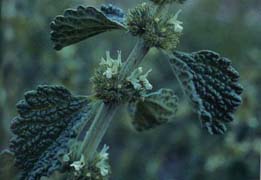Lemon Balm Family Name: Mint Family Name: Lamiaceae/ Labiatae Latin Name: Melissa Officinalis. The Latin species name Melissa, means, “bee-leaf” (Also Known As): Melissa Common Names: Sweet Balm, Lemon Balm, Melissa, Sweet Melissa, and Balm (8: 161) Native American Names: None found Related Species: Bergamot, Melissa Officinalis Sitting With/Dreams/Sense of the Plant: I have had no dreams about the plant, but I did study a dead lemon balm plant in the neighbors yard. I was surprised by how much lemon balm encompasses my yard and my neighbors yard. ¬¬¬¬¬_________________________________________________________________________ Body System Affiliations: (8: 163) 1. Digestive system 2. Skin 3. Nervous system _________________________________________________________________________ Botanical Description: Habit: Herb, Perennial Size: 2 feet Arrangement: Opposite Leaves: A light green, 1-3 inches long and become smaller toward the top. The shape is round with a triangular outline. (8: 161) Flowers: Size, Color, Shape Fruit: All flowering plants have fruits – What kind of fruit does this plant have? Underground Parts: Small fibrous root. Personal Observation and Description: All the lemon balm I have been around lately has been dead or has been winterized. They are all brown and crumbly. _________________________________________________________________________ Ecology: Habitat: Lemon Balm thrives in a more shady area. Range: Although it is now not found in the wild, it can be found along the Northwest coastline, and can be found inland along the Cascade Mountain range. (8: 161) Native Where: Native from Southern Europe, and naturalized in England. (5: online) _________________________________________________________________________ Western (European-American) Uses/Relationships: Food: Lemon balm is known for its intense flavor. It can season many different foods; most popular are fish, salads, and chicken. (2: online). They sometimes are also used to flavor specialty drinks. (3: online). Lemon Balm is popular in dessert treats such as cheesecake and ice cream. (6: online) Materials/Technology: None found. Medicine: Part Used: Whole herb Medicinal Actions: Anti-viral, analgesic, anti-spasmodic, anti-depressant (8: 163). Diaphoretic, mild sedative Indications: Menstrual cramps, herpes, deterrent to mosquito bites, depression, nervousness, emotional stress, stomach ache, diarrhea, gas pain, flu, common cold, fevers. (8: 163) Body System Associations: Repeat Constituents: Citral, citronellal, eugenol, acetate, geraniol, polyphenols, tannins, falconoid, rosemarinic acid, triterpenoids. (8: 163) Applications: Tincture, infusion, tea. Preparation: Tincture: 1 part to 5 parts 50% alcohol. (8: 163) Tea: Boil 32 parts water, remove form heat, and steam one part by weight of the herb in water for ½- 1 hour, depending on botanical. Pour through strainer until additional parts are reached. (8: 24) Pharmacy: Dry herb tincture: ½-1 tsp in hot water. Standard infusion: ¾ fluid ounces. (8: 163) Other: Lemon balm can be used to rub on the skin in order to repel mosquitoes. It is has some antibacterial properties, although they are not defined. (5: online) Cautions: Do not take lemon balm with alcohol, or with prescription medication. (7: vol.1) _________________________________________________________________________ Indigenous and Non-Western Use/Significance/Relationships: Medicine: Indigenous Group: Cherokee Part Used: Whole herb. Medicinal Actions: Cold, gastrointestinal aid, and Febrifuge. Indications: Cold: to help with common cold symptoms. Gastrointestinal aid: Used on small children and infants when stomach is upset. Febrifuge: Help with chills and fever aliments. (1: online) Energetics: None found. _________________________________________________________________________ Propagation: thrives in shady areas (9: 48) Technique: Cut back the stem after the flowers begin to show. (9: 48) Timing: Most seed the plant in the spring, and it begins to pop up from the ground between July and August. (4: online) Personal Experience: I have never planted lemon balm before. Harvest: Plant Part: Whole herb Season of Harvest: Early summer- mid summer Method of Harvest: Make sure to cut the stems below the leaves, then plant and make sure the plant will have plenty of sunlight, especially in the beginning stages. (4: online) Ecological Considerations of Harvest: Don’t put too close together. (4: online) Cultural Considerations of Harvest: None found. _________________________________________________________________________ Personal Experience: Food: I have made tea with lemon balm on occasion. Part Used: Tincture Desired Medicinal Actions: I was hoping to treat my sleeping problem. Targeted Indications: To help with sleep. Technique: I made tea with some honey right before bed. Processing: I boiled water and put in the correct amount of drops into the tea. Storage: Room temperature Experience: I didn’t feel any different when I drank the tea but I did go into a deeper sleep at night. Drawing: see Healing Gardens journal BIBLIOGRAPHY Website 1. Author unknown, Native American Ethnobotany website. University of Michigan © 2004. Viewed 2-13-07 www.herb.umich.edu [1] 2. Gernot Katzer’s “Spice pages” plant list section. Modified Dec. 17, 1999 http://www.uni-graz.at/~katzer/engl/Meli_off.html [2] 3. Grieve, M. “Botanical: A Modern Herbal Site” ©1995-2007 published by Botanical.com. Viewed 2-13-07 http://botanical.com/botanical/mgmh/b/balm--02.html [3] 4. Hyde, Brenda “Using and Growing Lemon Balm” The Garden Path © 1999-2006 Seeds of Knowledge-Old Fashioned Living www.seedsofknowledge.com/lemonbalm [4] 5. Sara’s Superb Herb website “Superb Herbs: Lemon Balm” http://www.superbherbs.net/Lemonbalm.htm [5] Viewed For food recipe on lemon balm: 6. Author unknown, “Lemon Balm ice cream” Your Recipes magazine, found on website. Posted July 10, 2005 www.myrecipefriends.com/recipe/73842.html?PHPSESSID=8537fa66af175e81e1f6... [6] Books, magazines 7. Karnick, C.R. 1994. Pharmacopoeial Standards of Herbal Plants, Vols. 1–2. Delhi: Sri Satguru Publications. 8. Michael Moore. Medicinal Plants of the Pacific West, Red Crane Books, ©1993 Santa Fe, New Mexico 9. Organic Gardening magazine, author unkown, July/August 2001 edition. Pg. 42-48 Dana Gilbert - Healing Gardens - Winter Quarter - 2007
